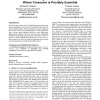Free Online Productivity Tools
i2Speak
i2Symbol
i2OCR
iTex2Img
iWeb2Print
iWeb2Shot
i2Type
iPdf2Split
iPdf2Merge
i2Bopomofo
i2Arabic
i2Style
i2Image
i2PDF
iLatex2Rtf
Sci2ools
94
Voted
GECCO
2007
Springer
2007
Springer
A building-block royal road where crossover is provably essential
One of the most controversial yet enduring hypotheses about what genetic algorithms (GAs) are good for concerns the idea that GAs process building-blocks. More specifically, it has been suggested that crossover in GAs can assemble short low-order schemata of above average fitness (building blocks) to create higher-order higher-fitness schemata. However, there has been considerable difficulty in demonstrating this rigorously and intuitively. Here we provide a simple building-block function that a GA with twopoint crossover can solve on average in polynomial time, whereas an asexual population or mutation hill-climber cannot. Categories and Subject Descriptors I.2.8 [Artificial Inteligence]: Problem Solving, Search – heuristic methods; F.2.2 [Analysis of Algorithms and Problem Complexity]: Non-numerical Algorithms and Problems. General Terms Algorithms, Performance, Theory. Keywords Mutation, crossover, modularity, building block hypothesis, genetic algorithms theory, royal roads.
| Added | 07 Jun 2010 |
| Updated | 07 Jun 2010 |
| Type | Conference |
| Year | 2007 |
| Where | GECCO |
| Authors | Richard A. Watson, Thomas Jansen |
Comments (0)

